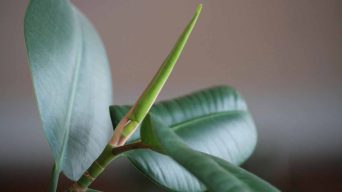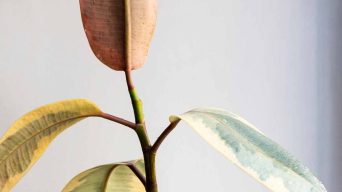Rubber plants (Ficus elastica) are one of the most popular houseplants and for a good reason.
They’re tough, adaptable, and easy to care for.
But even the most experienced plant parent can run into problems from time to time.
One of the most common issues is Rubber plant leaves drooping.
Why Are My Rubber Plant Leaves Drooping and How Can You Fix It?
There are a few different reasons your Rubber tree plant might have droopy leaves.
It could be that the plant is too wet or too dry, it’s not getting enough light, or the temperature is too cold, among others.
Here are seven possible causes of Rubber plant leaves drooping and what you can do to fix the problem.
1. Underwatering
Rubber plants are native to humid, tropical environments and thus prefer consistent moisture.
If your plant is wilting and its leaves are drooping, it’s likely due to underwatering.
Rubber plants can go without water for a little while, but they will start to show signs of stress if they’re not watered regularly.
They must be watered every 1-2 weeks or when the top inch of soil is dry.
How To Tell if Your Rubber Plant Is Underwatered
To tell if your plant is underwatered, stick your finger into the soil near the base of the plant.
If it feels dry to the touch, it needs water.
In addition to wilting and drooping leaves, other signs of underwatering include yellowing leaves, brown edges on leaves, and stunted growth.
How To Treat an Underwatered Rubber Plant
If you think your Rubber plant is underwatered, the best thing to do is give it a good watering.
Ensure to water the plant until water runs out of the drainage holes at the bottom of the pot.
Let the plant drain for a few minutes, then empty any water that remains in the saucer.
Once the plant has been watered, it should start to recover within a day or two.
2. Overwatering
While too little water can be a problem for rubber plants, too much water can also be an issue.
If your plant’s leaves are droopy and yellow, it may be a sign of overwatering.
Rubber plants don’t like to sit in water, so it’s essential to ensure the pot has good drainage and that you’re not watering it more than necessary.
How To Tell if Your Rubber Plant Is Overwatered
The best way to tell if your rubber plant is overwatered is to check the soil.
If it’s soggy or muddy, it means there’s too much water.
Other signs of overwatering include yellow or brown leaves, leaf drop, and root rot.
How To Treat an Overwatered Rubber Plant
If you think your rubber plant is overwatered, you must first stop watering it.
Allow the potting soil to dry out completely before watering the plant again.
Ensure that the pot has good drainage and that you’re not watering the plant more than necessary in the future.
If the plant still shows signs of stress, you may need to repot it in fresh soil.
3. Low Humidity
Rubber plants need high humidity to thrive.
If the air in your home is too dry, it can cause the leaves of your Rubber plant to droop.
This is especially common in winter when heating systems dry out the air.
How To Tell if Your Rubber Plant Needs More Humidity
There are a few ways to tell if your Rubber plant needs more humidity.
If the leaves are drooping, yellowing, or browning, it could be a sign that the air is too dry.
Other signs include leaf drop and stunted growth.
You can also use a hygrometer to measure the humidity in the room where the plant is located.
The ideal humidity level for Rubber plants is 60-70%.
How To Increase Humidity for Your Rubber Plant
If the air in your home is too dry, you can do a few things to increase the humidity around your Rubber plant.
One option is to place the plant on a pebble tray.
Fill a shallow dish with pebbles and water, and place the plant on top of the pebbles.
The water will evaporate and increase the humidity around the plant.
You can also use a humidifier to add moisture to the air.
Place the humidifier near the plant to benefit from the extra moisture.
4. Not Enough Light
One of the main reasons for rubber plant leaves drooping is not enough light.
Your plant needs bright, indirect sunlight to thrive.
If it’s not getting enough light, its leaves will droop and turn yellow.
How To Tell if Your Rubber Plant Needs More Light:
The easiest way to tell if your rubber plant needs more light is to look at the leaves.
If they are starting to turn yellow or pale green, this is a good indication that your plant isn’t getting enough bright light.
Another way to tell is by looking at the stems. If the rubber plant stems are long and leggy, this is another sign that your plant needs more light.
How To Increase Light for Your Rubber Plant
Rubber plants need bright, indirect sunlight to thrive. If your plant isn’t getting enough light, you can try moving it to a sunnier location.
The best place for a rubber plant is near a south- or west-facing window.
This will give the plant the bright, indirect light it needs without exposing it to direct sunlight, which can be harmful.
Make sure to move the plant slowly to adjust to the change in light levels.
You can also try using grow lights to give your plant the extra light it needs.
5. Temperature Stress
Rubber plants are tropical plants that originated in the warm, humid climates of Southeast Asia.
They typically grow in lowland forest areas and do not tolerate cold temperatures well.
Bringing your rubber plant indoors before the first frost is essential if you live in an area with cold winters.
These plants can also be sensitive to hot, dry conditions and should be protected from direct sunlight and heat sources.
In general, rubber plants prefer temperatures between 65 and 80 degrees Fahrenheit.
If the temperature drops below 60 degrees or rises above 90 degrees, your plant may become stressed.
How To Tell if Your Rubber Plant is Stressed by Temperature
There are a few signs that your rubber plant is stressed by temperature.
If the leaves are drooping or wilting, this is a good indication that the plant is not happy with the temperature.
Other signs include leaf drop, stunted growth, and browning leaves.
If you see any of these signs, it’s important to take action to correct the problem.
How To Fix Temperature Stress in Your Rubber Plant
If your rubber plant is stressed by temperature, there are a few things you can do to fix the problem.
First, ensure the plant is not exposed to direct sunlight or heat sources.
Move it to a location that is out of the way of drafts and away from doors and windows.
If the temperature in your home is too cold, you can try moving the plant to a warmer room or using a space heater to raise the temperature around the plant.
You can also try using a humidity tray or humidifier to increase the humidity around the plant.
6. Pests
Pests are another common reason for rubber plant leaves drooping.
These plants are particularly susceptible to mealybugs, spider mites, and scale.
Mealybugs are small, white insects that feed on the sap of plants.
They can cause leaves to turn yellow and drop off.
Spider mites are tiny spider-like creatures that live under the leaves of plants.
They feed on the plant tissue and can cause the leaves to turn yellow and drop off.
Scale are small, brownish insects that attach themselves to the stems and leaves of plants.
They suck the sap from the plant, which can cause the rubber plant leaves to drop off.
How To Tell if Your Rubber Plant Has Pests
There are a few signs that your rubber tree plant has pests.
If you see small white bugs on the leaves or stems, this is a good indication that the plant has mealybugs.
When you see small spider-like creatures on the undersides of the leaves, this is a good indication that the plant has spider mites.
If you see small brown bugs on the stems or leaves, this is a good indication that the plant has scale.
How To Get Rid of Pests on Your Rubber Plant
If your rubber plant has pests, you can do a few things to eliminate them.
First, you can use a soft cloth, or cotton swab dipped in rubbing alcohol to remove mealybugs and spider mites from the plant.
For scale, you can use a toothpick or other sharp object to remove them from the plant.
You can also use insecticidal soap or neem oil to kill pests.
These products are available at most garden stores.
7. Transplant Shock
Transplant shock is another common reason for rubber plant leaves drooping.
This usually happens when the plant is moved from one location to another or repotted.
The plant may also experience transplant shock if the roots are disturbed in any way.
How To Tell if Your Rubber Plant is in Transplant Shock
There are a few signs that your rubber plant is in transplant shock.
The leaves may start to turn yellow or brown, and they may drop off the plant.
The plant may also stop growing, and the stems may become weak and spindly.
If you see any of these signs, it’s important to take action to correct the problem.
How To Fix Transplant Shock in Your Rubber Plant
If your rubber plant is in transplant shock, there are a few things you can do to fix the problem.
First, make sure that the plant is in a location that receives bright indirect light.
The plant should also be in a location where the temperature stays between 65 and 75 degrees Fahrenheit.
It’s also essential to ensure the plant gets enough water.
Water the plant when the soil is dry to the touch, and empty any excess water from the saucer after watering.
Give the plant time to adjust to its new location; it should eventually recover.
How To Prevent Your Rubber Plant Leaves From Drooping
Rubber plants are generally easy to care for, but you can do a few things to prevent the leaves from drooping.
- Make sure the plant is getting enough sunlight. Bright indirect light is best for rubber plants.
- Be careful not to over or underwater the plant. Water when the soil is dry to the touch, and empty any excess water from the saucer after watering.
- Don’t let the temperature around the plant drop below 65 degrees Fahrenheit.
- Avoid letting the plant sit in drafts.
- Be careful not to overfertilize the plant. Feed with a balanced fertilizer once a month during the growing season and once every two months during the winter.
- Inspect the plant regularly for pests and take action to remove them if necessary.
- Transplant the plant to a new pot when it becomes rootbound.
These simple tips can keep your rubber plant healthy and prevent the leaves from drooping.
Final Thoughts
Rubber tree plants are generally very easy to take care of.
However, their leaves may droop for various reasons, including too much or too little water, insufficient light, or pests.
If your rubber plant’s leaves are drooping, try to determine the cause and take appropriate action.
In most cases, simply adjusting your plant’s watering or lighting schedule will solve the problem.
Drooping leaves are not a severe problem and can usually be easily fixed.
Just keep an eye on your plant and take action as soon as you notice any problems.
With some care, your rubber plant will return to its healthy self in no time!







